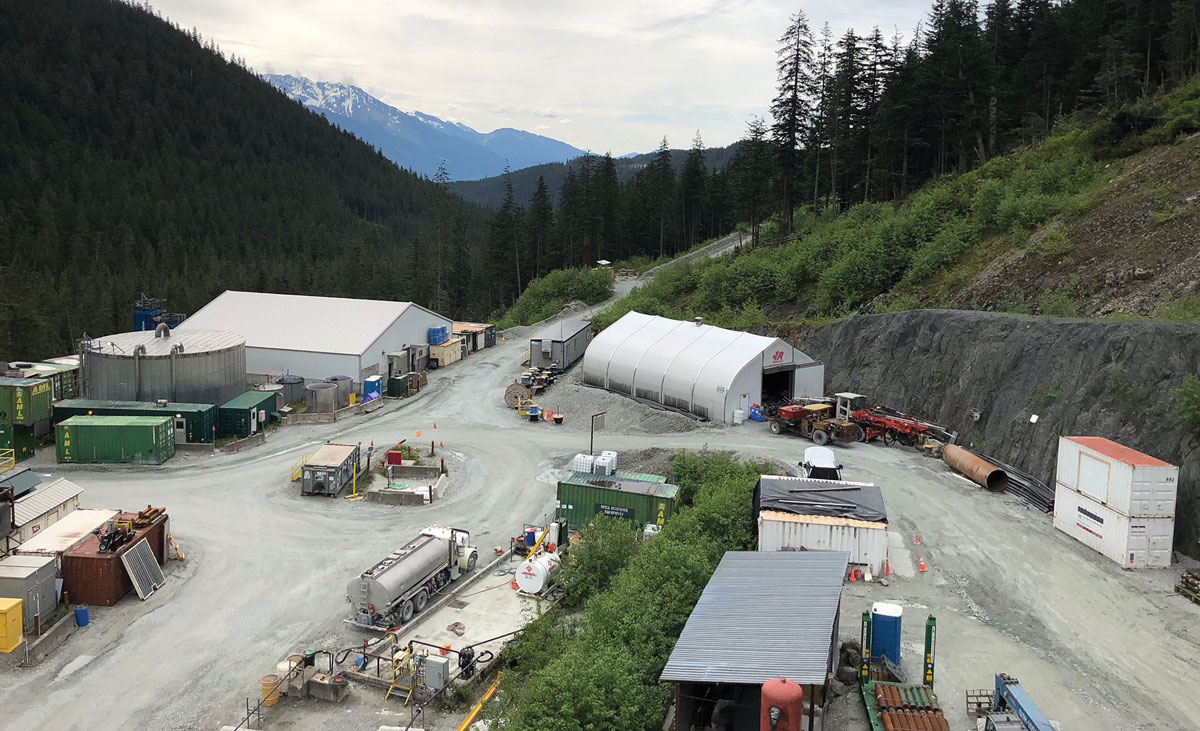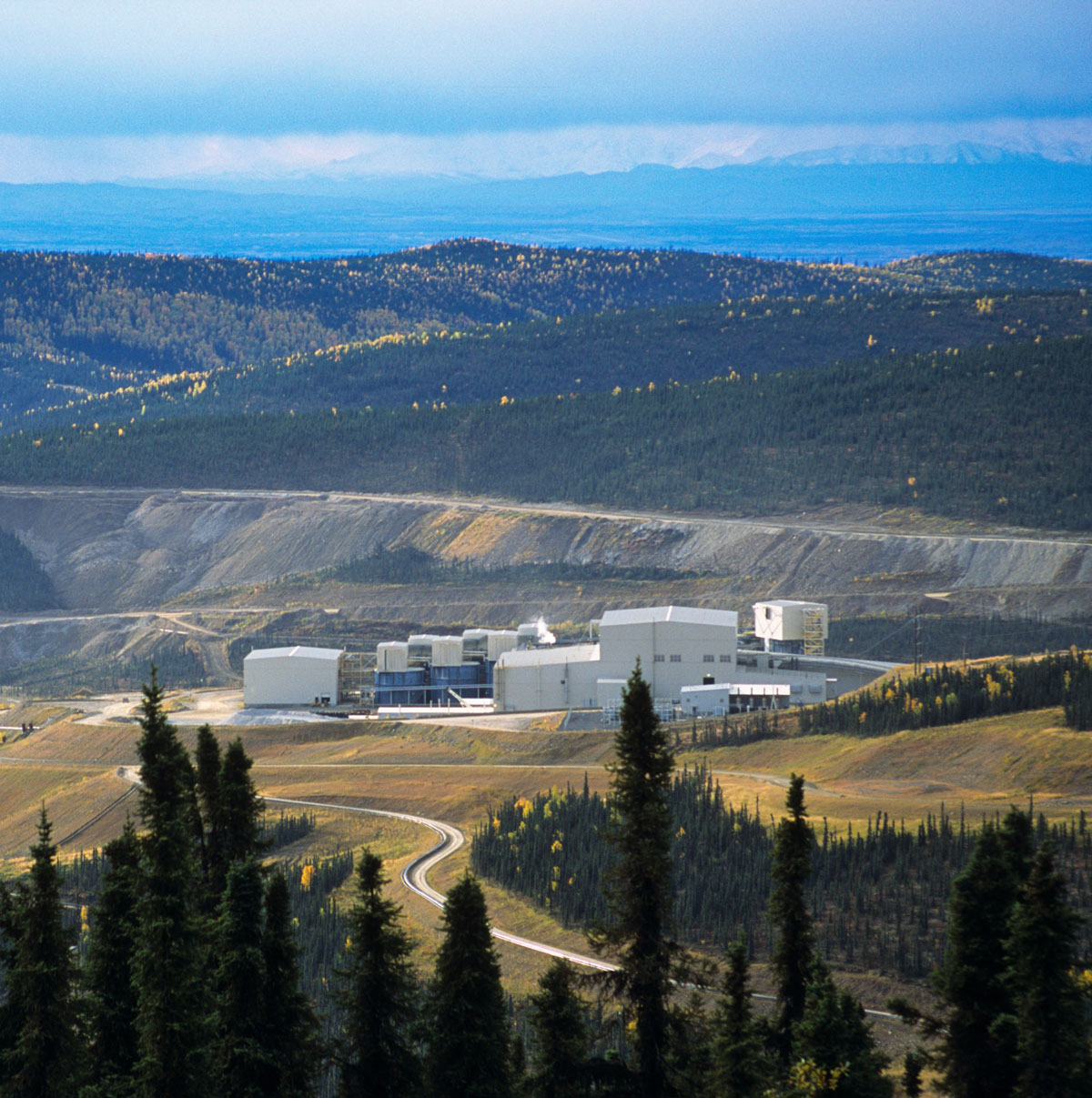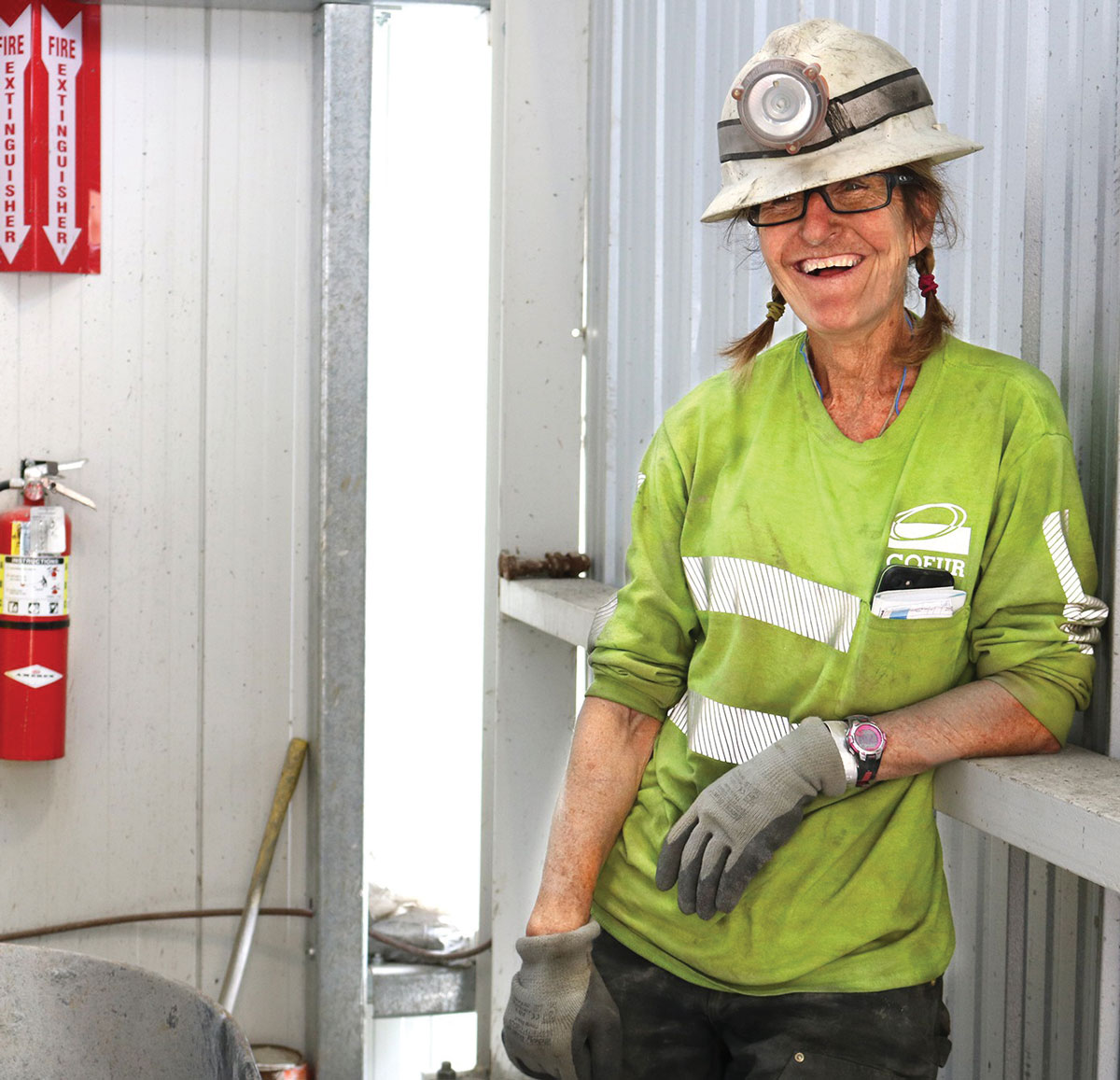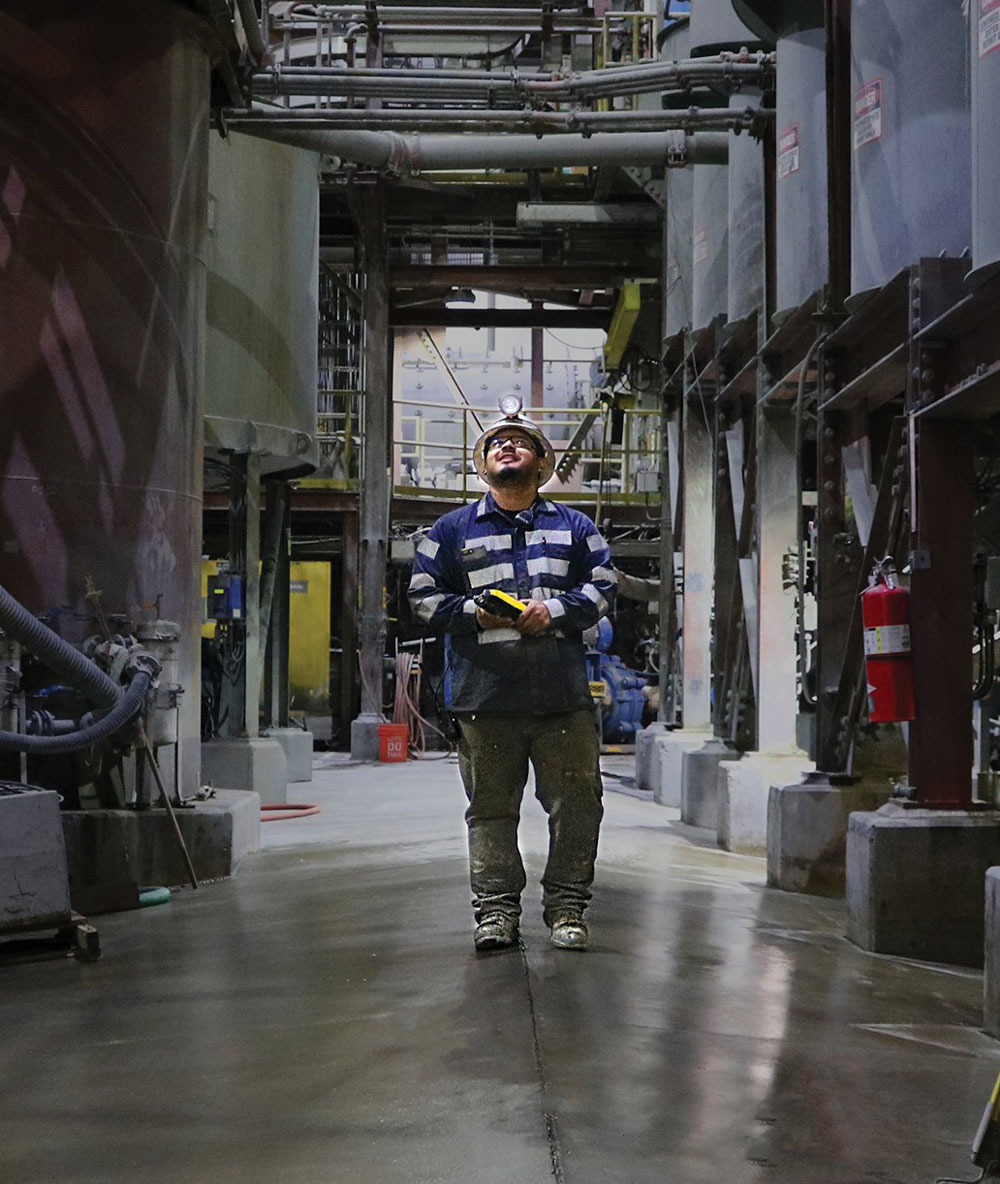very day, approximately 1,000 Alaskans go to work where the sun never shines. They are the miners in the tunnels at the Kensington, Greens Creek, and Pogo mines. Meanwhile, their cohorts at the Fort Knox, Usibelli Coal, and Red Dog mines labor with blue sky over their heads. Same industry, two different approaches to extracting minerals from the earth. Whether the risks and rewards of open pit versus underground mining make sense for any given site depends largely on the depth and nature of the deposit and the type of ore expected to be found.
Half of the six producing mines in Alaska are surface mines, where the landscape is scraped away to expose the mineral resource. Teck and NANA Regional Corporation’s Red Dog mine, north of Kotzebue, is a classic example: the country’s largest zinc and lead producer is visible from high altitude as a crater nearly a kilometer wide with concentric terraces leading to the bottom, which is usually filled with groundwater.
Alaska’s largest producing gold mine, Kinross’ Fort Knox, exhibits a similar shape: a terraced hollow northeast of Fairbanks. Seven miles away, the companion site of the True North mine remains visible on the landscape, though it has been officially reclaimed and restored after Kinross finished extracting gold from 2001 to 2004. Less evident past mining sites surround the Usibelli Coal Mine in Healy, where some pits dug since 1943 have been refilled and covered with fresh vegetation.
Coeur Mining Inc
Coeur Mining Inc

These types of mines are the most common method of mining throughout the world. Open pit mines are generally established in areas where deposits are found near the surface of the earth and typically become broader as mining progresses. Initially, the ratio of clearance necessary to access the deposit is in favor of the mine, but when it becomes inefficient to clear more of the surface to expand the mine, it is closed and reclaimed.
This form of mining allows for maximum maneuverability and access to deposits, making it the most efficient form of mining as most of the deposit is usually retrieved. It is also not subject to limitations in space, so various equipment may be utilized at the same time to enhance the mining process. Working conditions are also relatively safe if the mine is managed appropriately. However, the shape of the mine means landslides and rockfalls are common hazards. The type of rock strata and mineral deposits present also mean water management may be a pressing concern while maintaining or reclaiming the mine.
An open pit mine is only an option if the deposit it shallow enough, and this varies by location as well as the type of mineral or ore. Certain types of ore, such as coal and copper, are more common on the top layer of the rock strata than on lower layers. Open pit mining grants access to the majority of the deposit, which makes it a practical option when possible. As open pit mining is also more economically efficient, it can add to the overall profitability of the project if the mineral at hand is of a lower market value.
As the name suggests, underground mining refers to mining that takes place below the surface layer of the earth. This includes underground mining techniques such as the bord-and-pillar method and the longwall method. These operations usually entail the construction of a tunnel, as well as supporting essential infrastructure such as vents, that goes beneath the earth’s surface and aligns with the natural mineral deposit. This form of mining usually occurs when mineral deposits are found in a deep layer of the rock strata. Underground mining also requires a bigger investment in compact specialized equipment and is therefore more expensive. This is why underground mining is only employed for mineral deposits that hold a particularly high market value, such as gold or silver.
For example, Coeur Alaska’s gold and silver Kensington Mine, which is located in a steep valley northwest of Juneau and has a single terrace with two main buildings at the entrance on the hillside. Gold and silver extracted from underground are transported down a narrow road to a dock on Berners Bay.
Patrick J Endres | AlaskaPhotoGraphics.com
Patrick J Endres | AlaskaPhotoGraphics.com

Meanwhile, Juneau’s largest local taxpayer, the Hecla Greens Creek mine on Admiralty Island, might be mistaken from the air for a power plant, comprised of two main buildings and a disposal heap—the bustle of mining silver takes place underground. But that small profile allows it to operate inside a federally protected national monument, the only such operation in the country.
And Sumitomo’s Pogo Gold Mine, northeast of Delta Junction, likewise has two main buildings in a narrow, compact footprint. Pogo uses the cut-and-fill method, where horizontal slices into ore-bearing rock leave a void that is backfilled, progressing upward into the ore body, while the ore itself is dumped into chutes for removal from the mine’s lowest level.
In addition to unique equipment and expertise requirements, underground mining also calls for a greater emphasis on worker health and safety. Miners working in underground mines often face more hazards, such as cave-ins, exposure to toxic gases, or poor temperature regulation. Many of these hazards require constant monitoring so workers may be given ample time to evacuate in an emergency.
One underground miner described conditions he experienced working a 100-foot shaft at Happy Creek near Fairbanks in the 1930s as part of an oral history recorded in 2000 by the Pioneers of Alaska, Igloo #4. Doug Colp recalled lowering a flame into the darkness to check the air quality. “If we lowered the candles or the carbide lamp to the bottom and it didn’t go out,” he said, “then we figured it was safe to go down ourselves. If it went out, we’d still go down,” after flushing the shaft with steam from a boiler. (The recording is now accessioned into the Oral History Collection at UAF [H-2000-15] and available online at uaf.edu through “Pioneer Miners of Alaska Project Jukebox” at Doug Colp.)
Fortunately, technology has advanced, with air quality now monitored by a variety of instruments and shafts supplied with fresh air pushed by massive fans with power ratings in the hundreds of horsepower.
While underground mines require particular planning, they are also are known for their dramatically lower impact on the natural environment. As they stick closer to mineral deposits and do not significantly interfere with the surface, much of the natural surrounding ecosystem remains intact and unaffected by mining operations.
Coeur Mining Inc
Coeur Mining Inc

Coeur Mining Inc
Coeur Mining Inc

When it comes to comparing open pit and underground mines, it is not a question of which is inherently better, but what is more suitable for the particular circumstances of a site. Some aspects of one method of mining may make it a better option, depending on the area.
In general terms, mining operations in areas where the natural environment can withstand disruption, where the mineral deposit is located close to the surface layer of the earth, and where the mineral deposit is plentiful, yet of a lower market value, open pit mining would be the preferred mining method. While mining operations in areas where the natural environment is particularly delicate, where the mineral deposit is located deep within the earth’s surface, and where the mineral deposit is of particularly high market value, underground mines would be more desirable.
When considering risk, while underground mines are generally more hazardous for miners, open pit mines are generally more hazardous to the local environment. Ease of access also differs significantly, as open pit mines make it easier for miners to access and retrieve materials, while underground mines are limited in terms of space and equipment, so much of the mineral deposit may never be fully retrieved.
Ultimately, each form of mining has its own advantages and disadvantages, and which is better can only be judged appropriately when applied to a potential mining site. ![]()